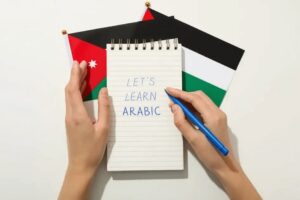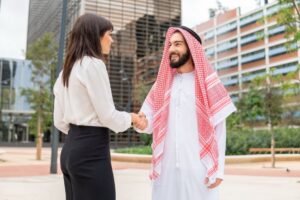
How Did the Arabic Dialects Arise?
Arabic is often taught and perceived as a singular language. However, what learners and travelers quickly discover is that spoken Arabic varies dramatically from one country—or even city—to another. While Modern Standard Arabic (MSA) is the official form taught in schools and used in formal settings, most Arabic speakers use local dialects in everyday life. So, how did this linguistic variety come to be?
Table of Contents
ToggleThe Roots of Arabic Dialectal Diversity
Arabic began as a group of tribal dialects in the Arabian Peninsula. As Islam expanded rapidly in the 7th century, so did Arabic. It absorbed, blended, and restructured depending on where it spread. By the time it reached North Africa, Persia, and the Levant, it was already evolving into regionally distinct forms.
5 Key Factors in Dialect Formation
1. Pre-Existing Languages
Arabic spread into areas already rich in linguistic traditions—like Coptic in Egypt, Aramaic in Syria, and Amazigh (Berber) in North Africa.
Examples:
- Moroccan Arabic retains Amazigh rhythm and pronunciation.
- Egyptian Arabic integrated Coptic grammar patterns and vocabulary.
These languages influenced local spoken dialects, especially in vocabulary and pronunciation.
These local tongues didn’t disappear—they blended into the new spoken Arabic, contributing loanwords, altered word orders, and local phonological traits.
Result: Each region’s dialect carries fingerprints of its linguistic past. For example, Egyptian Arabic adopted Coptic syntax in verb usage, while Moroccan Arabic reflects Amazigh influence in sound and rhythm.
2. Geographical Isolation
The Arab world spans deserts, mountains, rivers, and seas, which historically isolated populations from one another. These physical barriers limited contact and allowed distinct dialects to evolve in relatively self-contained speech communities.
Example:
- Coastal urban dialects (like Beirut or Alexandria) absorbed foreign trade influence
- Mountain and rural dialects (like in southern Jordan or northern Morocco) preserved older, conservative features
Map Idea:
In Jordan, Bedouin Arabic differs from urban Ammani Arabic due to tribal separation. Similarly, rural Lebanese Arabic varies from coastal Beirut dialects.
This isolation explains why even two dialects within the same country can be surprisingly different.
3. Trade Routes
Arabic was the lingua franca of commerce, especially along the Silk Road, maritime trade lanes, and camel caravans.
In each trade hub, Arabic absorbed terms related to:
- Products (e.g., spices, textiles)
- Professions (e.g., sailors, bankers)
- Foreign goods and concepts (from Persian, Turkish, Hindi, and more)
Impact:
As merchants traveled, they exchanged both goods and words. Arabic absorbed foreign terms from Persian, Turkish, Sanskrit, and even Chinese, enriching the spoken lexicon in trade-heavy regions.
Result: Port cities like Aden, Baghdad, and Tangier show greater lexical diversity and linguistic flexibility than inland towns.
4. Colonial Influences
During the 19th and 20th centuries, European colonial powers imposed their languages, which merged with local Arabic dialects—especially in administration, education, and media.
Modern Borrowings:
- French influenced Arabic in Morocco, Algeria, and Tunisia.
- English left a mark in Jordan, Egypt, and the Gulf states.
These borrowings are especially evident in everyday terms like “bus,” “radio,” and “police.”
5. Urban vs. Rural Divergence
Cities became centers of cultural exchange, while villages and nomadic tribes retained older forms of speech.
Urban areas, as centers of government, trade, and culture, facilitated rapid language change and innovation. Rural areas, meanwhile, preserved more conservative and ancestral features of Classical Arabic.
Jordan Example:
Urban Amman speakers often blend MSA with Levantine expressions.
Bedouin communities preserve conservative dialects with older Arabic roots.
Timeline of Arabic Dialect Development
7th Century – The Islamic Expansion
Arabic spread rapidly with the rise of Islam, reaching North Africa, the Levant, Persia, and parts of Central Asia.
While Classical Arabic (the language of the Qur’an) was standardized in writing, spoken Arabic began adapting to local languages and customs.
Early dialectal differences emerged due to contact with indigenous populations and minimal centralized regulation of spoken forms.
13th Century – Regional Distinctions Emerge
As major Islamic centers (e.g., Cairo, Damascus, Baghdad, Córdoba) developed their own schools of thought and cultural norms, so did their spoken Arabic.
Literary works, poetry, and music reflected emerging regional flavors, though Modern Standard Arabic (MSA) had not yet formalized.
Dialects became more prominent in oral tradition, while Classical Arabic remained the medium of science and religion.
19th Century – Colonial Impact and Media Influence
European colonization introduced new administrative and educational systems, embedding French and English vocabulary into daily speech, especially in North Africa and the Levant.
The invention of the printing press and later radio and television encouraged the adoption of MSA as a middle-ground between Classical Arabic and dialects.
However, the divergence between formal and informal Arabic deepened, with dialects becoming more dominant in homes, streets, and entertainment.
20th–21st Century – Mass Media & Globalization
TV shows, movies, music, and digital platforms further elevated dialect use. Egyptian Arabic rose to prominence through its entertainment industry, while MSA remained dominant in news and formal writing.
Satellite TV, pan-Arab networks, and the internet enabled greater exposure to different dialects, increasing mutual understanding but also highlighting complexity.
In education and diplomacy, MSA remains the official language, but real-world communication—especially in informal settings—leans heavily on dialects.
Modern Implications of Dialect Diversity
1- Media Challenges
TV shows in Egyptian Arabic dominate across the Arab world, but regional content in Moroccan Arabic or Sudanese Arabic often needs subtitles—even for fellow Arabs.
Example: A Jordanian may struggle to understand a Moroccan sitcom due to vocabulary, pronunciation, and French loanwords.
2- Business Communication
MSA is still the default in formal emails, legal contracts, and cross-border meetings, but dialects often sneak into conversation.
Solution: Learning both MSA and spoken dialects—like what’s taught at AlBaher Arabic Language Center—prepares students for academic, professional, and everyday Arabic.
How AlBaher Teaches Dialect Awareness?
At AlBaher Arabic Language Center, students don’t just learn MSA—they learn to listen, understand, and adapt across dialects. Lessons show how the same idea is expressed in different dialects and in MSA. Example:
- MSA: “كيف حالك؟”
- Egyptian: “إزيك؟”
- Jordanian: “كيفك؟”
Students match spoken phrases to their regional origins using audio clips from Morocco, Jordan, Iraq, and Egypt. It’s a fun and memorable way to build listening skills.
Role-playing classes place students in historic Silk Road cities or medieval courts to see how dialect and MSA functioned side by side.
Final Thought
Understanding how Arabic dialects arose gives learners cultural depth and linguistic flexibility. Whether you’re watching TV shows, navigating spoken Arabic, or preparing for academic study, knowing both the roots and modern applications of Arabic will make you a more confident communicator. At AlBaher Arabic Language Center, we turn language into living history.
You may also like

Learn Arabic for Beginners: From Letters to Real Conversations


